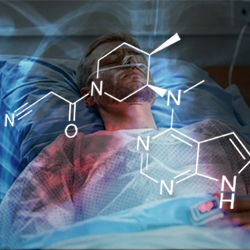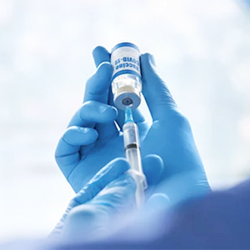By Meaghan Lee Callaghan and Marie Rosenthal, MS
Another Janus kinase (JAK) inhibitor appears effective in reducing death and respiratory failure in patients hospitalized with COVID-19 pneumonia.

STOP-COVID, a double-blind, placebo-controlled study, evaluated the safety and efficacy of tofacitinib (Xeljanz, Pfizer) in 289 hospitalized adults with COVID-19 pneumonia who were not receiving ventilation.
Patients from 15 hospitals in Brazil were randomly assigned to receive either tofacitinib 10 mg twice daily plus standard of care or placebo twice daily plus standard of care for up to 14 days or until hospital discharge. Standard of care frequently included steroids, and 89.3% of patients were given glucocorticoids, predominantly dexamethasone, during hospitalization. In addition to steroids, patients may have received antibiotics, anticoagulants or antiviral agents.
However, they did not receive concomitant biologic agents, immunosuppressants other than steroids, interleukin (IL)-1 or IL-6 inhibitors, another JAK inhibitor or a potent cytochrome P450 inducer.
The patients were 18 years of age or older with laboratory-confirmed SARS-CoV-2 infection and radiographic evidence of pneumonia. They had been hospitalized for less than 72 hours when enrolled in the study. Patients who required any type of mechanical ventilation—invasive or noninvasive—or extracorporeal membrane oxygenation, had a history of thrombosis, active cancer, or known immunosuppression were excluded.
The researchers assessed study patients daily up to day 28 during hospitalization. For patients who were discharged before day 28, follow-up occurred on days 14 and 28. The primary outcomes were death or respiratory failure.
The trial demonstrated a lower cumulative incidence of death or respiratory failure through day 28 with tofacitinib (18.1%) compared with placebo (29.0%) (risk ratio, 0.63; 95% CI, 0.41-0.97; P=0.04). Death from any cause through day 28 occurred in 2.8% of patients in the tofacitinib group and in 5.5% in the placebo group (hazard ratio, 0.49; 95% CI, 0.15-1.63) (N Engl J Med 2021 Jun 16. doi:10.1056/NEJMoa2101643).
“In this particular study, all patients were treated according to local standards of care for COVID-19. This medication regimen included steroids, as well as antibiotic agents, anticoagulants and antiviral agents, but the results demonstrated a statistically significant lower incidence of death or respiratory failure between the tofacitinib and placebo,” explained Renee Baiano, PharmD, CSP, a clinical program manager at AllianceRx Walgreens Prime.
“Although these results were seen in a small population, this offers another therapeutic option to treat patients who have contracted the virus,” she said.
When added to the standard of care, tofacitinib “may further reduce the risk of death or respiratory failure in this patient population,” said Otavio Berwanger, MD, PhD, the lead investigator and director of the Academic Research Organization, Hospital Israelita Albert Einstein, in Sao Paulo. “The study builds on the hypothesis that JAK inhibition could mitigate systemic and alveolar inflammation in patients with COVID-19–related pneumonia.”
This is a well-done and important study, according to Dr. Baiano and other experts who did not participate in the study but who spoke to Infectious Disease Special Edition.
“This is another study showing that Janus inhibitors can have benefit in COVID-19,” said Aaron E. Glatt, MD, the chair of medicine and chief of infectious diseases at Mount Sinai South Nassau, in Oceanside, N.Y. “We are always looking for drugs that have benefit with COVID. Many drugs that we originally were using have not been ultimately proven to be effective. This along with some of the other Janus inhibitors, like baricitinib [Olumiant, Lilly], appear to be of benefit.”
Not only does this provide another potential weapon in the armamentarium against severe COVID-19, but it highlights that “inflammation is driving much of the clinical worsening in people who are hospitalized with severe COVID-19,” explained Rajesh Tim Gandhi, MD, an infectious disease specialist and a professor of medicine at Harvard Medical School, in Boston. “This is why steroids, anti–IL-6 drugs and JAK inhibitors have shown benefit in people who are severely ill and hospitalized with COVID-19.”
Class Effect
Tofacitinib is an approved drug used to treat rheumatoid arthritis and other autoimmune disorders.
“Tofacitinib, in combination with steroids, was effective in this population as the results show,” said Roy Fleischmann, MD, MACR, the co-medical director Metroplex Clinical Research Center and a professor of medicine at the University of Texas Southwestern Medical Center, in Dallas. “This is not surprising because of the mechanism of action of JAK inhibitors. Another study done with baricitinib in combination with remdesivir [Veklury, Gilead] was also successful.
“It was thought that the baricitinib study was successful because the baricitinib molecule interferes with the ingress of the virus into the cells and not because of its anti-cytokine activity. Yet, this study with tofacitinib showed that JAK inhibition was key,” Dr. Fleischmann said.
Tofacitinib “inhibits the signaling between different inflammatory cells, thus tamping down the inflammatory response in either rheumatoid arthritis or COVID-19 infection,” explained Donald Miller, PharmD, a professor of pharmacy practice at North Dakota State University College of Health Professions, in Fargo.
The unregulated immune response leading to elevated cytokine levels and hyperinflammation, called the cytokine storm, produces dangerously high fevers, extreme fatigue, a sharp drop in blood pressure and can severely damage the lungs and other organs. So, there is a lot of interest in dampening this reaction, the experts said.
“The role of adding an inhibitor like this to steroids is unclear. But if we knew all the answers, we would not be looking so desperately for different treatment mechanisms,” Dr. Glatt said, “but certainly Janus inhibitors seem to be providing benefit. Since you have two drugs in this class, it’s not just a quirk. It does look like it’s a class effect.”
When to Add
The biggest question is when to add drugs like JAK inhibitors and interleukins, and for which patients, the experts said.
“The role of adding an inhibitor like this to steroids is unclear. Which is the best one to add at what point in time? We don’t know the optimal combination at this point, and every time you combine one of these agents, you are immunosuppressing the patient, and there is a real risk of potentially getting bacterial or fungal or parasitic superinfections,” Dr. Glatt admitted. “We really don’t know the optimal way to use these classes of agents, and studies like these are giving us more information.”
Timing is a really important consideration, Dr. Miller added. “The question of when to use tofacitinib in COVID-19 is all important,” he said. “It should be most effective early in the inflammatory process. However, not all patients with COVID-19 will have an uncontrolled inflammatory response. Most patients will have a mild infection, so choosing the right population for this drug is important, but difficult.”
This is where one’s clinical acumen is crucial, Dr. Glatt explained. “These are used in sicker patients. You don’t want to start giving these immunosuppressive drugs earlier than it’s been shown that they have benefit. It is a mistake to give them too early. So, there is a ‘sweet spot’ that you want to try and find where the patient is sick enough to need them, but not too sick that they won’t get any benefit from them,” he said.
For him, that is usually a patient who is hospitalized and whose oxygen saturation is falling below 94%. “That’s when you want to give these agents,” he said, adding that it was important to stay up to date on the literature when deciding which of these agents to consider.
Dr. Gandhi said he would also consider adding one of these drugs if the person requires oxygen and has high inflammatory markers on lab testing.
“For a person with severe COVID-19 who requires oxygen, I would definitely give dexamethasone. In someone who has rapidly worsening oxygen requirement and has blood tests that show increased inflammation, I would combine dexamethasone with either an IL-6 blocker or a JAK inhibitor,” he said, adding that no one knows which would be the best option.
“A head-to-head trial would be extraordinarily informative,” Dr. Gandhi said.
Tofacitinib carries a warning about deep vein thrombosis (DVT), so that fact might weigh into a clinician’s consideration, according to Dr. Fleischmann, but he said there is a caveat. “In this study, almost all patients were on prophylactic anticoagulants because of COVID-19, and thus you would not expect to see a VTE [venous thromboembolism] with the addition of tofacitinib. If they were not on anticoagulants, then the argument would be if the patient wanted to take the small risk of VTE, and the risk is small—an incidence rate of 0.3 per 100 patients years—or the risk of death from COVID, which is not small. The risk/benefit would almost certainly be in favor of tofacitinib.”
The researchers found serious adverse events occurred in 20 patients (14.1%) in the tofacitinib group and 17 (12.0%) in the placebo group. Among protocol-specified adverse events, DVT, acute myocardial infarction, ventricular tachycardia and myocarditis occurred in one patient each in the tofacitinib group; hemorrhagic stroke and cardiogenic shock occurred in one patient each in the placebo group. The incidence of serious infection was 3.5% in the tofacitinib group and 4.2% in the placebo group.
“When treating COVID-19 complications, the patient’s medical provider would consider the seriousness of COVID-19 pneumonia and the patient’s risk factors, including risk of thrombosis, while weighing the benefits and risks for the patient,” Dr. Baiano said.
Dr. Miller said one should monitor for clots and new infections. However, “fortunately, there was not an increase in either in the tofacitinib patients.”



